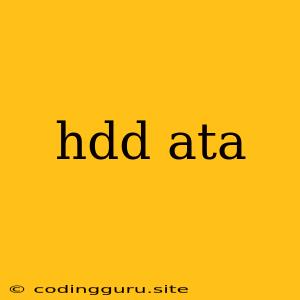Understanding HDD ATA: A Guide to the Interface for Your Hard Drive
The world of computer hardware can feel like a labyrinth of cryptic terms and complex technologies. One such term, often encountered when dealing with hard drives, is HDD ATA. This acronym stands for Hard Disk Drive Advanced Technology Attachment, and it's a crucial interface that allows your computer to communicate with your hard drive.
But what exactly is HDD ATA, and why should you care?
HDD ATA is a standard interface that defines the way your computer interacts with a hard drive. Essentially, it acts as a bridge between your computer's motherboard and your hard drive, enabling data transfer and communication. Think of it like a language that both devices understand.
Why is HDD ATA important?
HDD ATA plays a crucial role in the performance and functionality of your computer. It determines how fast data can be read and written to your hard drive, ultimately impacting how quickly your computer loads programs, opens files, and performs everyday tasks.
The Evolution of HDD ATA
HDD ATA has undergone several revisions throughout its history, each bringing improvements and increased speeds.
-
IDE (Integrated Drive Electronics): This was the initial version of HDD ATA, commonly referred to as PATA (Parallel ATA). It used parallel data transfer, meaning information was sent across multiple wires simultaneously. PATA was the dominant interface for hard drives for many years.
-
SATA (Serial ATA): SATA emerged as a successor to PATA, employing serial data transfer, sending information over a single wire in a continuous stream. SATA offered significant improvements in speed, efficiency, and flexibility compared to PATA.
Understanding the Differences: PATA vs. SATA
Here's a quick rundown of the key differences between PATA and SATA:
- Data Transfer Method: PATA used parallel transfer, while SATA uses serial transfer.
- Speed: SATA offers significantly faster data transfer rates than PATA.
- Connections: PATA uses wider, ribbon cables, while SATA uses slimmer, individual cables.
- Power: SATA requires less power than PATA.
- Compatibility: SATA is backward compatible with some PATA devices but not vice versa.
Choosing the Right HDD Interface
While SATA is the current standard and offers superior performance, you might still encounter PATA connections on older computers. Here's how to determine which interface you need:
- Check your Motherboard: Look for available SATA or PATA connectors on your motherboard.
- Check your Hard Drive: Most modern hard drives come equipped with SATA interfaces.
Troubleshooting HDD ATA Issues
If you encounter issues with your HDD ATA connection, try the following troubleshooting steps:
- Reseat the Connections: Ensure the hard drive and data cable are securely connected to the motherboard.
- Check the Cable: Ensure the data cable is not damaged or frayed.
- Update Drivers: Ensure that your system's drivers are up to date.
- BIOS Settings: Check your BIOS settings to ensure the hard drive is recognized and enabled.
Conclusion
Understanding HDD ATA is essential for navigating the world of hard drives. Whether you are building a new computer, upgrading your existing system, or troubleshooting hardware problems, understanding the role of this interface will help you make informed decisions and ensure your computer performs at its best.
While SATA has become the dominant interface for modern hard drives, PATA remains relevant for older systems. By understanding the differences and following basic troubleshooting steps, you can ensure your hard drive is properly connected and functioning optimally.
